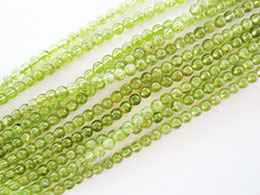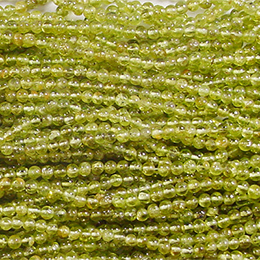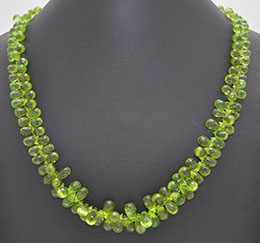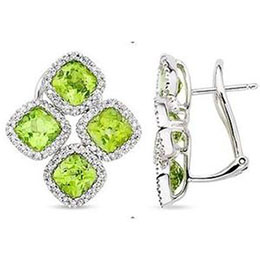Peridot Gemstone

Peridot became popular all through the Crusades, especially when Peridot was established to Europe for religious purposes. It also became extraordinarily popular during the Baroque era (~1500-1700 A.D.) in Europe. During that time, Peridot became most wanted for rich monarchs. In the modern day, Peridot is regularly used in the casting industry because of its high melting point of 1200-1900 degrees Celsius.
In addition to, these gemstones have the tendency to crack quite easily, so they are not to cut carefully. In fact, Peridot will not cleave when being cut, but they will rupture when excess stress is applied on the gem. Another significant thing to remember when choosing Peridot stone is that there are stones that are similar with peridot such as diopside, chrysoberyl, emerald, and prehnite.
Colours:
Peridot is considered as one of the few stones, which subsist only in only one colour. Its colour mediator is iron that accounts for the deep green colour with golden hue. Chemically, Peridot is composed of an iron-magnesium-silicate, and the concentration of its colour, significantly depends on the quantity of iron contained. The colour is come in any distinction from yellow-green and lime to brown-green.

Sources:
Peridot deposits are mostly found in several parts of the world, including several locations with broad ophiolite sequences, such as Arizona, Australia, Brazil, China, Egypt, Kenya, Myanmar, Mexico, Pakistan, and Tanzania. In fact, the most prominent deposits are discovered in Pakistan and Egypt. One significant ophiolite series was originated from on Zabargad Island of Egypt, which produced historical significance, as well.
Emotions:
Peridot is believed to be valuable when it comes to curing emotional afflictions, as well. It is a magnificent stone to assist someone who is going through despair. It is a stone of frothiness that eliminates the effects of pessimistic emotions. It has the capability to balance the method of emotional release and removes out any negative emotions, and taking them to comfortable levels.
In addition to, Peridot promotes emotional stability, sanctuary, as well as, peace. It soothes anxiety and lightens emotional pain. Also, Peridot banishes exhaustion, which can bother someone who is suffering from depression. The stone’s force balances bipolar disorders and other types of depression and assists individuals self-worth or bruised ego. It also conveys an indispensable change, which is much required to someone who is totally miserable.
Holistic Aspects:
Peridot has been believed to treat illnesses of the liver and difficulties in absorption. It is helpful in physical detoxification and facilitates to treat issues in bladder, kidneys, and the stomach. It is also helpful in treating ulcers, constipation, and bad-tempered bowel syndrome. It is also helpful in healing insect bites, which provides tonic effect and provides regenerated tissues.
Also, it strengthens the metabolism and helpful for the skin. It cures the thymus, heart, spleen, and lung. If positioned on the abdomen, it can strengthen the muscle contractions while reducing the pain. Peridot is also helpful in healing skin illnesses and difficulties related with the endocrine systems and adrenal glands. It is also use to cures fevers.
Moreover, Peridot opens, rinses out and activates the heart, which can assist an individual to discharge old stuff. All burdens, fault and obsessions become unfurnished and mental clarity and happiness begin. Peridot makes the person a productive individual. It shows you how to disconnect yourself from external influences and how to come across with your own energies for guidance.
It assists in moving forward rapidly in therapeutic situations. It also helps you understand your destiny and spiritual purpose, helping you attain your full potential. All in all, the stone sharpens the mind and opens it to new levels of awareness. Also, anger is an emotion peridot has been known to be very beneficial for. The stone calms the nervous system, helping to dissolve emotional tensions and bringing balance to the system.

Other Aspects:
Peridot stone attracts love and soothes raging anger from within. It alleviates jealousy, resentment, and spite, and reduces stress. Additionally, this stone can be particularly useful, especially for those individuals who are having self-esteem problems. These stones also enhance self-assurance and allegation without violence.
Moreover, it also helps the individual to perceive the radiance and identify that they are worthy for love. It helps in looking back to the past at unenthusiastic experiences, and teaches a person how to let off himself. Peridot facilitates deal with guiltiness, whether it is self-imposed, or the product of others controlling ways.
It can assists you to confess your mistakes and go on, taking dependability for your own life, especially when you think it is all somebody else’s fault. It also facilitates individual, especially for those who believe they have slight personal control as working with such stone or keeping you to provide an additional improvement you might need.
It also increases the individual’s energy level, endorsing strength both physiologically and emotionally, as well. It is revitalizing, refreshing, and supporting access to individual’s internal vision and happiness. Peridot also has other psychosomatic effects as well as, various uses. It can also help an individual to conquer hypochondria.
Peridot is a gem with a long and fascinating history. Mined in antiquity on the Egyptian island of St. John, in the Red Sea, peridot is a golden-green variety of a mineral called olivine. It includes hues from leek-green to yellow-green. Due to its distinctive green colour, this gem has alternately been confused with emerald and chrysoberyl. In fact, legends say that peridot was a favourite gemstones of Cleopatra's and that some of the so-called emeralds worn by her were actually peridot.
 Peridot can be found in Egyptian jewelry from the early 2nd millennium B.C. and is mentioned in the Bible by the Hebrew name of pitdah. The stones used at that time came from a deposit on a small volcanic island in the Red Sea, some 45 miles off the Egyptian coast at Aswan, which was not rediscovered until about 1900. Quality peridot gems come from Arizona, Burma, Norway, the Red Sea, Hawaii, and sometimes from meteorites.
Peridot can be found in Egyptian jewelry from the early 2nd millennium B.C. and is mentioned in the Bible by the Hebrew name of pitdah. The stones used at that time came from a deposit on a small volcanic island in the Red Sea, some 45 miles off the Egyptian coast at Aswan, which was not rediscovered until about 1900. Quality peridot gems come from Arizona, Burma, Norway, the Red Sea, Hawaii, and sometimes from meteorites.
The origin of the word is perhaps the French word "peritot," meaning unclear, possibly due to the inclusions and cloudy character of large stones. The word may also come from the Arabic word "faridat," meaning gem.
Peridot is the birthstone for the month of August. Peridot is not particularly hard, only 6.5 to 7 on the Mohs scale. Its composition is (Mg, Fe) 2(SiO) 4.
Peridot is said to encourage openness in the solar plexus, relieving tense situations. Physically, it is thought to rid the body of toxins and stimulate complete tissue regeneration. It is also thought to strengthen the spleen and the pancreas.
Emotionally, peridot is believed to clear behaviour that is not conducive to the realization of the self, lessen nervousness, and balance and align energy to heal the ego.
For any investors, collectors or lovers of peridot, we recommend a gemological identification Certificate of Authenticity. This is an independent report, issued by an independent gemologist, from an approved gemology laboratory.

Comment (0)